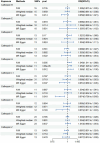Genetic Insights Into the Role of Cathepsins in Alzheimer's Disease, Parkinson's Disease, and Amyotrophic Lateral Sclerosis: Evidence From Mendelian Randomization Study
- PMID: 39740768
- PMCID: PMC11688054
- DOI: 10.1002/brb3.70207
Genetic Insights Into the Role of Cathepsins in Alzheimer's Disease, Parkinson's Disease, and Amyotrophic Lateral Sclerosis: Evidence From Mendelian Randomization Study
Abstract
Background: Previous studies have confirmed the significant role of cathepsins in the development of neurodegenerative diseases. We aimed to determine whether genetically predicted 10 cathepsins may have a causal effect on Alzheimer's disease (AD), Parkinson's disease (PD), and amyotrophic lateral sclerosis (ALS).
Methods: We conducted a two-sample bidirectional Mendelian randomization (MR) study using publicly available data from genome-wide association study (GWAS) to assess the causal associations between 10 cathepsins and three neurodegenerative diseases, including AD, PD, and ALS. We employed the following methods, including inverse variance weighting (IVW), MR-Egger, and weighted median (WM). The results were further validated using sensitivity analysis.
Results: The forward MR analysis results indicate that elevated cathepsin H levels increase the risk of AD (p = 0.005, odds ratio [OR] = 1.040, 95% confidence interval [CI] = 1.011-1.069), elevated cathepsin B levels decrease the risk of PD (p < 0.001, OR = 0.890, 95% CI = 0.831-0.954), and no significant association was found between cathepsin levels and ALS. Reverse MR analysis suggests that there is no causal association between 10 cathepsins and three neurodegenerative diseases.
Conclusion: Our study provides new genetic insights into the role of cathepsin H in AD and cathepsin B in PD. However, our findings need to be further validated in a wider population, and future research should explore the potential mechanisms of cathepsins in these diseases in order to provide a basis for the development of new therapeutic strategies.
Keywords: Alzheimer's disease; Parkinson's disease; amyotrophic lateral sclerosis; cathepsins; mendelian randomization.
© 2024 The Author(s). Brain and Behavior published by Wiley Periodicals LLC.
Conflict of interest statement
The authors declare no conflicts of interest.
Figures




Similar articles
-
Are neurodegenerative diseases associated with an increased risk of inflammatory bowel disease? A two-sample Mendelian randomization study.Front Immunol. 2022 Sep 8;13:956005. doi: 10.3389/fimmu.2022.956005. eCollection 2022. Front Immunol. 2022. PMID: 36159838 Free PMC article.
-
Cysteine cathepsins and autoimmune diseases: A bidirectional Mendelian randomization.Medicine (Baltimore). 2024 Oct 25;103(43):e40268. doi: 10.1097/MD.0000000000040268. Medicine (Baltimore). 2024. PMID: 39470488 Free PMC article.
-
Genetic insights into the role of cathepsins in cardiovascular diseases: a Mendelian randomization study.ESC Heart Fail. 2024 Oct;11(5):2707-2718. doi: 10.1002/ehf2.14826. Epub 2024 May 7. ESC Heart Fail. 2024. PMID: 38714485 Free PMC article.
-
Associations of environmental factors with neurodegeneration: An exposome-wide Mendelian randomization investigation.Ageing Res Rev. 2024 Mar;95:102254. doi: 10.1016/j.arr.2024.102254. Epub 2024 Feb 29. Ageing Res Rev. 2024. PMID: 38430933 Review.
-
Mitochondrial DNA copy number and Alzheimer's disease and Parkinson disease.Mitochondrion. 2025 Jul;83:102032. doi: 10.1016/j.mito.2025.102032. Epub 2025 Mar 27. Mitochondrion. 2025. PMID: 40157623
References
MeSH terms
Substances
LinkOut - more resources
Full Text Sources
Medical
Miscellaneous

